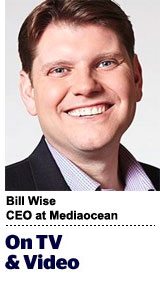“On TV And Video” is a column exploring opportunities and challenges in advanced TV and video.
Today’s column is written by Bill Wise, CEO at Mediaocean.
TV’s digital moment has arrived. Within the very week in which Netflix and Amazon scored Oscar wins, YouTube announced YouTube TV, its planned subscription service bringing major network content to YouTube viewers. The volume of IP-delivered TV continues to swell, while the demand for more precise TV measurement grows.
Assuming the effort succeeds, YouTube TV will do more than just push Alphabet higher in the ranks of online programming. The service, featuring live network shows and sports from more than 40 providers, effectively turns YouTube into a quasi-cable company. If you’re looking for a sign that digital programming has hit prime time, YouTube TV seems to be it.
If online programming is here in such a big way, is the advertising industry ready to make the most of the opportunity? From the perspective of measurement – the analyses that help advertisers decide the value of an ad spot based on how many people and audience types are likely to see it – the answer seems to be a resounding “not quite.”
Digital Measurement, At The Pace Of TV
To understand the measurement challenge of bringing programming online, a good place to start is with the simple question of how often advertisers need measurement at all.
In traditional TV, marketers and agencies need a tremendous amount of information to guide their advertising decisions, but they only need that information at a handful of times throughout the year. That’s because, traditionally, TV advertisers have used long-term strategies to buy TV spots well in advance – largely at annual upfronts.
But as viewers and advertisers fan out across more channels, new advertising options help increase the pace of business. For instance, the rise of cable TV gave advertisers more advertising choices. Those choices, in turn, meant advertisers could spend less on the upfronts and more on last-minute deals via the scatter ad market. More options helped drive a faster advertising cycle.
On the digital front, the same story is playing out at far greater scale. With a dizzying array of devices, outlets, ad impressions and personalized targeting to choose from, marketers face a never-ending stream of options for the next ad investment. At every step, more ad choices mean more decisions, and more decisions require a constant stream of data to make sense of the endless options cropping up at any given moment.
Online programming, of course, is another force introducing more ad choices and more complexity, for TV and digital advertisers alike. Marketers need far more to-the-moment viewership data to guide them through all the decisions. Does the existing TV measurement provide that kind of recency?
How Precise Is Precise Enough?
Often, the prevailing programming measurement – the GRP – is not delivered as a constant stream of insight. While daily reports in the form of overnight ratings are available, a vast amount of critical TV viewership stats are based on aggregate information gathered and shared over weeks and months, not days or hours. That could mean that TV measurement isn’t delivered frequently or fast enough for the pace of a fragmented digital market.
TV measurement also isn’t as precise as many marketers would like. Until recently, it’s been impossible to track the viewing habits of every household in America. Instead, traditional measurement companies record the viewing habits of representative samples of the population – at times through set-top box and other technologies, and at other times through surprisingly antiquated methods like viewers’ self-reported notes in paper booklets.
For TV advertisers, the resulting estimates are often less than ideal, but still a workable solution. But as media platforms converge and advertising options increase, advertisers have vastly more choices to make, and they need data in greater volumes, with more precision and at greater speed. Will the less-than-ideal data continue to be usable? Probably not. And so the measurement approaches will need to evolve.
For its part, Nielsen – the reigning TV measurement firm – is working fast to bring TV measurement into a digital age, from its Digital Ad Ratings services to its work leveraging social media chatter to understand TV viewership. Meanwhile, Nielsen’s main competitor, Rentrak, merged with digital measurement leader comScore early last year. There’s good reason for optimism that the TV measurement business is poised to steward advertisers into the new world of online shows.
At the same time, it’s equally clear that ad measurement will need to reinvent itself as TV programming expands into its digital home. Are advertisers and the measurement business ready to change channels? Stay tuned.
Follow Mediaocean (@TeamMediaocean) and AdExchanger (@adexchanger) on Twitter.












